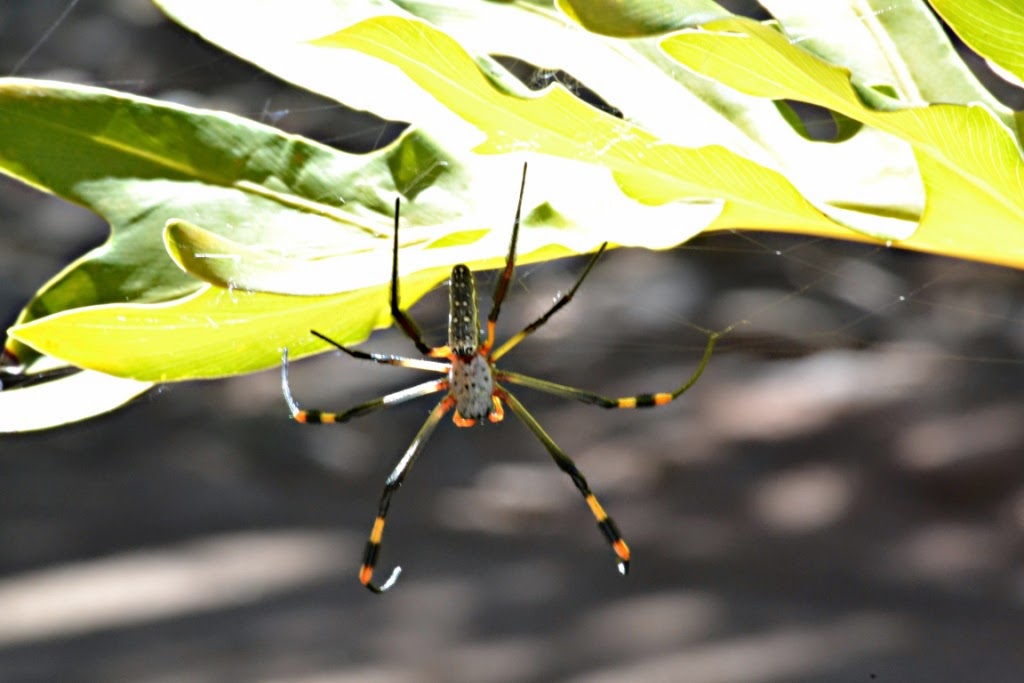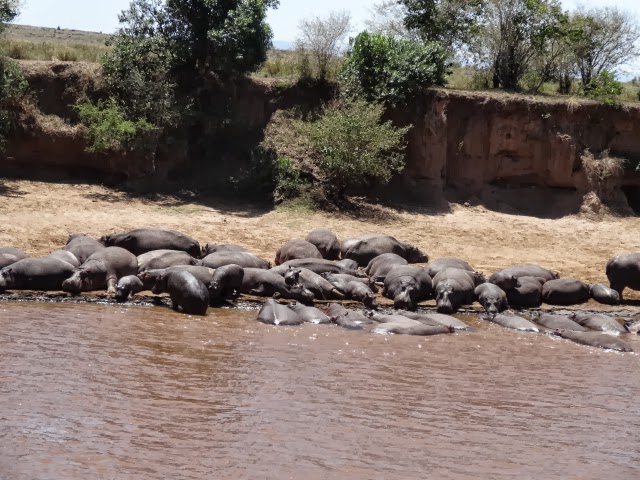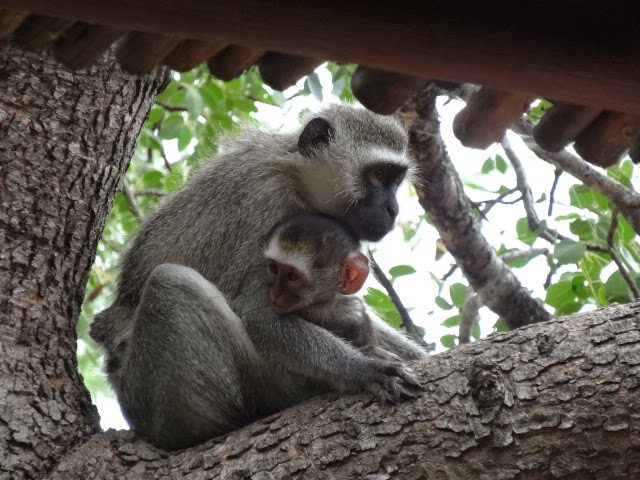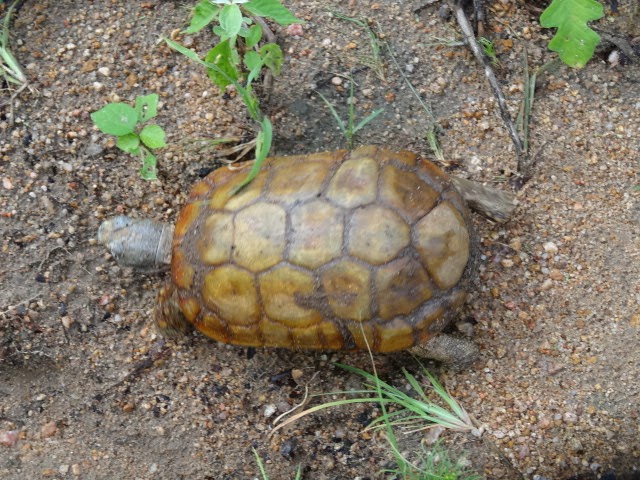 |
| This mom was looking out for her baby to the right as we watched from the road in front of African Reunion House early this morning. |
It was 5:45 am and after our another great night’s sleep at African Reunion House, we were both awake and ready to get outdoors. The sun was up, the sounds of the birds wafted through the air, and nature was calling to us.
 |
| Shaded by dense vegetation and early morning sun hidden behind the trees, we weren’t able to get closer for better shots. Plus, giraffes are so tall, one can’t get too close in order to get a good photo. |
I was in the other bedroom where I shower and dress to hear Tom yell out to me, “Giraffes! Hurry!”
 |
| This is the surprise room set among the treetops in African Reunion House, a fully screened Jacuzzi room on the second level. The temperature in this room is surprisingly about 20% less than the outdoor temperature. The surprise room is located off one of the two upstairs bedrooms, shown in the photos below. |
 |
| One can imagine the charm of a glass of wine, the candles lit, surrounded by the sounds of nature while soaking in the relaxation of the whirling jets of warm water. Hum…seems like this may be a perfect end to Valentine’s night after the game drive and bush braai! |
“Grab the camera!” I yelled back as I hurriedly threw on shorts and shoes, still in my sleep tee shirt. We were out the door in less than a minute.
 |
| One of the two upstairs bedrooms, this is the room off of which the surprise room is located which also includes an en suite bathroom with a double shower. |
Tom was standing in the doorway between the house and the veranda checking out the status of the tree frog, still hanging out on a beam in the ceiling. He looked out toward the road to see a tail and tall legs.
 |
| This beautiful “nguni,” cow rug sets the theme of the room. |
Running out the front door, we gasped when we saw them, four of them, nibbling on the treetops, on the road outside the house. We never cease to be amazed nor do the residents we’ve met in Marloth Park. No matter how long they’ve lived here they never stop feeling their hearts pound with excitement when they see the majestic giraffes, especially in their neighborhood.
 |
| Another view of that exquisite bedroom off of the surprise room upstairs. The décor is lovely. Notice the matching vanity seat on the left under the built-in vanity table and the items on the bed. An elegant African theme followed through the entire house. |
And this morning we were given the treat to see them at African Reunion House reminding us when we first arrived at the little house that 12 giraffes came down the driveway to visit. Click here for the link. It was December 14th, two weeks after we’d arrived in Marloth Park, a day we’ll always remember. And four of them came another time. And one came alone racing through the yard on a mission.
 |
| Only Danie would think of placing a spigot inside of a tree. Clever! Befitting! |
This morning, although not as close as our past experiences, the excitement was palpable, our sensible caution, preventing us from getting too close, as we carefully approached the four giraffes this morning. Giraffes are gentle by nature but their sheer size can result in serious injury or in the case of a resident in Marloth park some time ago, death from an injury from getting too close.
 |
| The second late afternoon visit in a row, Mrs. Warthog was as happy to see us as we were her and her four babies. |
They knew we were there as the mom kept a watchful eye on us as the baby stood nearby. After a few photos, they began to wander away, as did we. Our day was complete and it was only 6:30 am. We’d seen giraffes. What more could we want?
 |
| With leftover cut-up fruit from yesterday’s breakfast with guests, the warthog family was thrilled to get fresh fruit which they eat off of the trees and bushes as they wander through Marloth Park. We’d removed all the pits from the apples, plums, nectarines, pears, and apricots. The only fruit they didn’t eat was apricots which in the shrink-wrapped package I’d purchased at the grocery store, turned out not to be ripe. They’d take a bite only to spit it out. |
We’ll take whatever comes our way, whether it be a tree frog as the same one from yesterday continues to observe us from the rafters, an unusual insect, a bird, a dung beetle, a warthog, or a zebra. We’ve loved them all! Big and small.
 |
| See the slice of unripe apricot they refused to eat? Mom and one baby were looking at us for more fruit that they would eat. We complied. How could we resist? |
Tasks for today? A trip with Okee Dokee to pick up a few items at the little house and to the handy little nearby shopping center to buy beer for Tom. With Jabula closed while Dawn and Leon are on vacation in Cape Town, we’ve been making dinner. Once they return on the 18th, we’ll be anxious to return a few more times for the great food and festivities.
As for Valentine’s Day, around 4:00 pm, we plan to go on another four-hour guided game drive and nighttime bush braai in Kruger National Park all cooked and hosted by Louise and Danie. Dining amid the wildlife, once again, we’ll feel safe with armed guards (with rifles) ensuring our safety. The food, always delicious will include many items I can enjoy. What could be more romantic than being entrenched in nature with the person we love? Nothing. Absolutely nothing!



































































